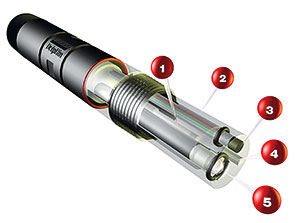Advanced pH sensor technology from Foxboro
June 2018
Sensors & Transducers
Foxboro has been manufacturing pH probes and transmitters for over seventy years. Using this field-proven experience, the company has now developed the Dolphin series of pH sensors.
Due to the advances in manufacturing techniques and the discovery of new materials, today’s pH sensor technology looks and operates differently. In pH probes of the past, the reference junction had to be kept wet at all times. In the latest Foxboro pH sensor technology incorporated in the Dolphin series, the entirely solid-state reference junction is manufactured from Nafion and Ceramic, which eliminates the need for wetted parts.
1. Double junction reference tube using a Nafion Barrier. 2. High temperature gel. 3. RTD and solution assembly. 4. Ceramic reference junction. 5. Unique spherical or flat glass pH electrodes.
The probes body is manufactured from PVDF (polyvinylidene fluoride, commercially known as Kynar), which incorporates the microprocessor-based smart electronics where all the sensor data and calibration curves are recorded and stored. The probe also has features built-in, temperature compensation and the digital signals from sensor to transmitter are less prone to RFI/EMI interference than conventional analog signals.
An added benefit of the Dolphin series is that users can connect the probes directly to a PC or laptop for ease of use. Via FDT and DTM certified software, the probes can be calibrated in the workshop prior to installation. In addition, information can also be extracted from the probe for maintenance and diagnostic purposes.
In summary, the advantages of the Dolphin series pH probes include:
• Unique Nafion ion barrier prevents reference junction fouling and reduces the need for cleaning.
• Rugged PVDF sensor body is chemical and abrasion resistant, resulting in longer service life.
• No metallic wetted parts, results in corrosion resistance and longer life in strong chemical solutions.
• Unique pH electrode formulations, both flat glass for abrasion resistance and domed glass for high-temperature service.
• Enhanced diagnostics reduce the amount of time required to assess sensor health.
• Unique sensor mounting design provides faster insertion and removal from the process.
• Kyner sensor body and a rugged electrode result in reduced breakage during handling.
For more information contact Johan van Jaarsveldt, EOH, +27 (0)87 803 9783, [email protected], www.eoh-pas.co.za
Further reading:
Miniature inductive sensors
ifm - South Africa
Sensors & Transducers
The inductive IY/IZ type sensors from ifm are used in various industrial areas where space is limited.
Read more...
The expanding role of 3D cameras in industrial quality control
TANDM Technologies
Sensors & Transducers
Across factory floors, warehouses, mines and research centres worldwide, computer vision paired with 3D camera technology is revolutionising quality control.
Read more...
PDS implementation on mines
Sensors & Transducers
Level 9 vehicle intervention for collision avoidance has been mandatory on South African mines since 2022, yet the effective roll-out of proximity detection systems remains slower than expected. This is not due to the technical limitations of integration but to operational readiness on site.
Read more...
Monitoring analogue process values
ifm - South Africa
Sensors & Transducers
Everywhere in industry, electronic sensors are used to detect process values such as temperature, pressure or flow. Process value monitoring often takes place directly in the sensor.
Read more...
Protecting buildings’ embodied carbon with retrofitted systems
Schneider Electric South Africa
Sensors & Transducers
The World Economic Forum has said that around 80% of the buildings in existence will still be around in 2050; it is therefore essential that in order to combat climate change we retrofit them for energy efficiency.
Read more...
Listening for damage to wind turbines
Sensors & Transducers
The Fraunhofer Institute for Integrated Circuits, working in concert with the Fraunhofer Institute for Wind Energy Systems, has developed a solution that can be used to identify cracks and breakage inside wind turbine blades remotely at an early stage.
Read more...
Enhancing gold leaching efficiency
Endress+Hauser South Africa
Sensors & Transducers
Endress+Hauser offers a range of advanced technologies designed to enhance the stability and accuracy of pH and dissolved oxygen measurements on gold processing plants.
Read more...
Powering safer mining with PDS
Sensors & Transducers
With the mining industry under increasing pressure to prioritise safety without compromising productivity, Booyco Electronics is pushing the boundaries of Proximity Detection System and Collision Avoidance System technology across both underground and surface operations.
Read more...
The car of the future listens
Sensors & Transducers
The perception of external sounds in cars has been lacking, even in automated driving. That is why Fraunhofer IDMT-HSA is researching the integration of acoustic sensor technology in its KI4BoardNet project with the Hearing Car.
Read more...
Telco Sensors for blocked or empty chute detection
Sensors & Transducers
In most industries there is a problem with photoelectric sensors as highly contaminated environments make it difficult to operate and sense reliably. Telco Sensors overcomes this through its powerful high-performance infrared sensors that ensure penetration of harsh pollution to guarantee reliable detection.
Read more...


